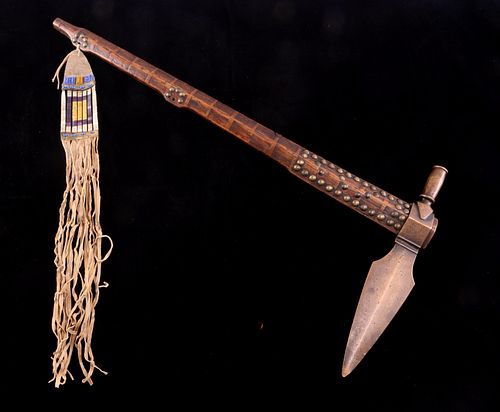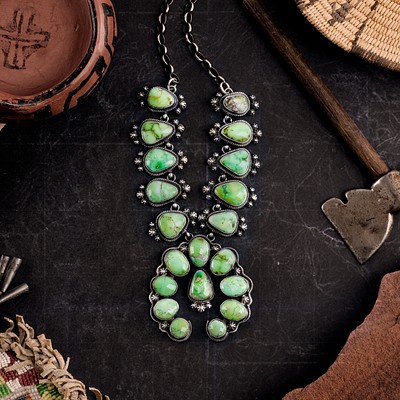Sioux Brass Pipe Tomahawk w/ Quilled Drop c. 1870
Two ways to bid:
- Leave a max absentee bid and the platform will bid on your behalf up to your maximum bid during the live auction.
- Bid live during the auction and your bids will be submitted real-time to the auctioneer.
Bid Increments
| Price | Bid Increment |
|---|---|
| $0 | $5 |
| $50 | $10 |
| $100 | $25 |
| $500 | $50 |
| $1,000 | $100 |
| $2,000 | $250 |
| $5,000 | $500 |
| $10,000 | $1,000 |
| $25,000 | $2,500 |
| $100,000 | $5,000 |
About Auction
Sep 11, 2021
A truly phenomenal sale ranging from American Indian History, Montana and Cowboy History, Antiques and Amazing Navajo Turquoise Jewelry to Luxury Diamond and Montana Sapphire pieces. North American Auction Company tucker@naabid.com
- Lot Description
This is an outstanding solid brass spontoon pipe tomahawk attributed to the Sioux Native American Indians of South Dakota of circa 1870. The piece features a solid brass spontoon kite-shaped flaring blade with no basal processes or spurs, showing a double edge and median ridge running down the center of both sides. The eyelet hole or eye hole of the head is diamond shaped, which has been documented by such authors and scholars as Harold Peterson, John Baldwin, Francis, Hartzler & Knowles, etc. as dating to the 1870 Indian Wars time period. The piece has prominent moldings and a raised “V” shaped chevrons, which flow into the tall, slender vase-like bowl, which also shows a prominent molded ring at the center and base. The haft or handle is solid hardwood and is decorated with extensive hot-file brandings and old solid brass square shank tacks in an obvious pattern. The wood has a nice shiny, deep patina and the head has a rich, mellow, almost green patina from honest age and use. The haft starts as a very angular diamond shape at the eyelet hole and begins to taper down with a slight up curve getting smaller and shows a hewn undercut, which frames the smaller more rounded gripping area with two pierced sections, one which previously would have held a drop or wrist throng and the other that holds the beautiful drop of quilled and beaded hide with fringe. The drop shows an Indian tanned buckskin hide with parfleche rawhide strips and buckskin long frilly fringe. The drop is adorned with unique, larger period correct glass pony trade beads and seed beads in an off blue, greasy yellow, and semi-transparent rose or Cheyenne pink. The center of the drop, which has the parfleche strips, are covered in an iconic square geometric pattern of all porcupine quills quillwork in natural pigment colors of yellow, purple, and (natural) white. The brass tacks up near the head show a long rectangular pattern with winding, almost zig-zagging line that could possibly represent an old clan, tribe, or previous owner’s name, but could also represent a landscape feature (such as a river) or animal (such as a snake). At the pierced holes around the gripping area, there are four (total) “U” shaped tacked designs possibly representing an animal hoof, such as a Buffalo, Elk, or Horse. This is very similar to the example in figure 271, page 133 of Harold L. Peterson’s “American Indian Tomahawks” book from 1965; the example in the book is dated to circa 1860-1880 and has a “classic so-called ‘Minnewauken’ form with the kite-shaped blade almost a diamond…. Slight median ridge running down the blade” (MAI/HF: 22/7292). Another very similar example can also be seen at Cisco’s Gallery in Coeur d’Alene, Idaho; it is described as a brass spontoon pipe tomahawk from the ex-collection of Dr. Myers, dating to the Mid-19th Century; it shows the kite-shaped blade being absent of basal processes and shows prominent moldings and diamond shaped eyelet hole with proudly raised chevrons leading to the tall, slender, slightly tapering bowl. This example is listed at $30,000. Provenance: From the ex-collection of Dale Harrison of Ohio and collected at the Santa Fe Indian Artifacts show over 20 years ago. This is a wonderful Indian War era example in scarcely seen solid brass manufacture with wonderful kite-shaped spontoon blade and rich haft, all having an honest patina from age and use. Tomahawk measures overall 24.25” long with an additional 19” long drop that is 2 1/8” wide. The tomahawk head is 12” long by 2.5” wide by 1 3/8” deep.
- Shipping Info
-
North American Auction Company is proud to announce the opening of our new in-house, full-service shipping department. We have listened to you the customer and will now be handling all outgoing packages in our new shipping department. We are confident this new offering will allow for a smooth transition from auction block to your front step. We have partnered with preferred carriers to ensure a safe, efficient delivery that works best with your schedule. Please allow 14-21 days after complete invoice payment is made to package and ship your purchase. After you are notified of your winning bids from our company and your item invoice is paid in full our new shipping department will contact you. Make sure when signing up with our company that your preferred shipping information is up to date as this information will be used to estimate shipping cost. Once the items have been packaged our team will contact you for shipping payment. Shipping invoices and payment will be completely separately than the items invoice. Please notify the shipping department with any alternate request or instructions at mark@northamericanauctioncompany.com or 800-686-4216 ext. 3. For a shipping quote please contact the same information above. PLEASE NOTE a shipping quote price can fluctuate in price. Auction company is not responsible for actual shipping cost being higher than quoted shipping cost. Thank you for trusting North American Auction Co. with your bids and shipping. As our shipping department is brand new please understand that delays can be expected.
-
- Buyer's Premium



 EUR
EUR CAD
CAD AUD
AUD GBP
GBP MXN
MXN HKD
HKD CNY
CNY MYR
MYR SEK
SEK SGD
SGD CHF
CHF THB
THB





























